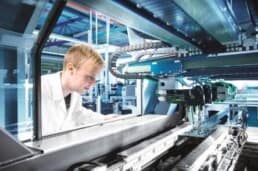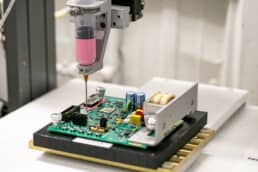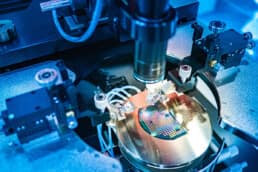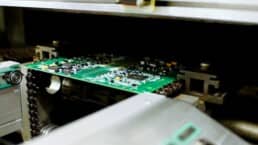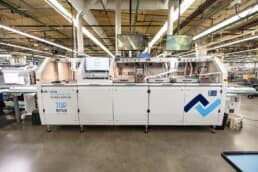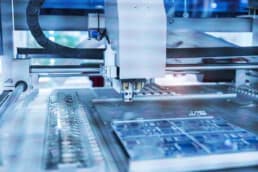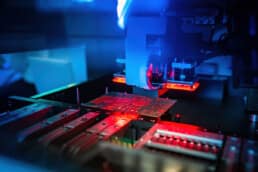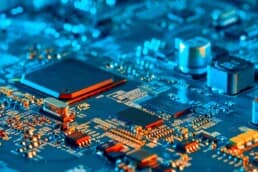The Value of Automation in PCB Assembly
In today’s factories and manufacturing facilities, automation is everywhere. It isn’t easy to imagine a production or assembly line without it. Industrial automation uses control systems and equipment, such as computer software and robots, to perform tasks historically done manually. These systems operate equipment automatically, significantly reducing operator involvement and oversight required. Automation technologies often consist of feedback loops and sensory programs. These loops and programs can adjust operating parameters as necessary based on real-time data. The automation technologies used in printed circuit board assembly (PCBA) have advanced significantly in recent years. This is largely due to the digitalization of manufacturing, especially with the Industrial Internet of Things (IIoT). IIoT has opened up more opportunities for companies to take advantage of the benefits of PCBA automation. Innovations in automation enable manufacturers to mass produce and assemble printed circuit boards (PCBs) more easily. PCB production and assembly efficiency has become a vital component in electronics manufacturing. Many parts of the manufacturing process can be automated, from design to PCBA. Original equipment manufacturers (OEMs) should work with their manufacturing partners to design with automation in mind. They should also be mindful of the order of post-production steps and component orientation to ensure efficiency during assembly. These design considerations help ensure that PCBA processes downstream are optimized and efficient. There are several PCBA automation technologies, and the value added comes in different forms. These technologies deliver speed and precision, resulting in lower cycle times and higher product quality. With automated PCBA, personnel no longer have to execute repetitive, time-consuming tasks. This reduces the risk of human error and allows personnel to focus on more value-added responsibilities. Additionally, as little as one operator can control highly automated PCBA processes, further reducing labor and manufacturing costs. Below is a deeper dive into the many benefits of automation in PCBA and the value it delivers. At RiverSide Integrated Solutions (RIS), PCBA is a core competency. Watch our short video to learn more about our PCBA solutions and our commitment to quality. OEMs have historically assembled PCBs manually, leading to slow production with more frequent quality issues. Instead, automated PCBA manufactures significantly higher volumes in a much shorter time. Robotic processes can work 24/7 with occasional outages for maintenance, all without sacrificing quality. This is faster and higher quality than human operators can perform. For this reason, increased efficiency and higher throughput rates are two of the biggest benefits of automation in PCBA. Moreover, robots are typically more versatile and flexible than humans. Changes can be programmed into the automation software. This eliminates the need for training and provides a quick turnaround for production changes. It also further increases operations productivity. In addition to elevated efficiency, automation allows OEMs to collect valuable data from the assembly line. They then use this data to improve maintenance. Predictive maintenance is a new approach primarily made possible with the IIoT and smart manufacturing. OEMs use real-time data to identify potential issues and alert operations personnel when maintenance is needed. Doing so reduces manufacturing downtimes, which leads to higher operations efficiency and lower costs. At RIS, PCB assembly is one of our core competencies. We provide reliable, seamlessly-assembled printed circuit board systems built with extreme precision. Our skilled engineers, technicians and assemblers work to expertly put together a complete PCBA. When you choose RIS, you can expect the hands-on customer care of a small operation with the capabilities characteristic of a larger company. We provide our complete electronics manufacturing services for OEMs in any industry. Our electronics assembly expertise includes:THE INDUSTRIAL INTERNET OF THINGS

AUTOMATED PCBA TECHNOLOGIES
INCREASED EFFICIENCY
DECREASED DOWNTIME
RIS PCBA EXPERTISE
About RiverSide Integrated Solutions
RIS is an advanced contract manufacturer providing robust solutions in circuit board assembly and product assembly. We employ more than 350 people and provide services to OEMs worldwide. We operate two state-of-the-art manufacturing facilities within the US.
With all of the choices in contract manufacturers out there, we know it can be challenging to find someone who understands your business model and has your best intentions in mind. RIS has always proven to be a win-win-focused relationship.
As your one-stop shop, we have the capabilities, capacity, quality assurance standards and resources to support all of your manufacturing needs. We understand that supply chain management is complex and very time-consuming, so we urge our customers to utilize us in the fullest capacity.
Our total-package solutions include:
- Extensive supply-chain network
- Full box-build assembly
- Dedicated Program Team
- Warehousing, kitting and drop-shipping capabilities
- Reverse logistics
- Flexible order fulfillment
- Scalability to meet your needs
Contact us today at (507) 523-3220 to see how we can help with your manufacturing project, or click contact us for a quote.
Ins and Outs of PCB Technologies
The printed circuit board (PCB) is at the heart of every electronic device. We interact with PCBs numerous times throughout our day. From laptops and cell phones to smart TVs and refrigerators; they’re everywhere! However, most people do not fully understand what a PCB actually is or how it works. In the simplest form, PCBs consist of sheets of non-conductive substrate overlaid with circuitry. This circuitry is typically copper and provides the necessary conductivity. Typical substrate materials include fiberglass and polyester. Electronic components, such as resistors, transformers, transmitters and capacitors, are connected to the board. To form a functional circuit, traces connect the various components to the overlaid circuitry. As technologies advance, PCBs shrink in size but grow in capability. This is due mainly to the demand for more portability and higher functionality. The popularity of hand-held and wearable devices for consumer and commercial markets is largely pushing this trend. High-density circuitry is an amazing advancement that has enabled smaller, more tightly packed boards for these devices. PCB assembly (PCBA) providers must keep up with rapid advancements. This means being able to assemble smaller, more complex panels without sacrificing quality. To help with this, many original equipment manufacturers (OEMs) outsource their PCBA to a reliable contract manufacturer. When selecting a PCBA supplier, OEMs must choose a partner, like Riverside Integrated Solutions (RIS), that employs advanced technologies. At RIS, we focus on meeting the challenges that PCB innovations present at every turn. Below are the ins and outs of the latest in PCBs and PCBA technologies. There are several different types of assembled PCBs. The type is selected based on the application of the electronic device. This factors in the desired functionality, complexity and spatial limitations. Below are some common forms of PCBs. These are the least complex and are easiest to manufacture. The boards have a single layer of conductive material and only occupy one side of the substrate. As the name suggests, this type has conductive material on the top and bottom of the substrate. This type denotes a board with more than two conductive layers. Multi-layer PCBs are often 4-, 6-, or 8-layer panels. OEMs utilize these in more complex electronics applications. PCB designers must also determine the level of flexibility in the printed circuit board. Traditional PCBs are rigid and inflexible, but flexible PCBs are gaining popularity. Flexible PCBs, categorized as flex, have more bend and can withstand more movement than traditional rigid PCBs. There is also rigid-flex, a hybrid option that offers the best attributes of both rigid and flex technologies. Rigid-flex PCBs typically contain flexible layers attached to one or more rigid boards. To remain competitive, PCBA providers must broaden their expertise. At RIS, we offer all PCB arrangements and the associated assembly processes for each. Our customers receive reliable, seamlessly assembled PCB systems built with extreme precision. Watch our short video to learn more about our PCBA expertise and solutions. Two primary techniques for joining components to the PCB during assembly are surface mount and through-hole. We describe each in more detail below. This technology is the most widely utilized for PCBA. As the name implies, surface mount technology (SMT) attaches components directly to the surface of the PCB. Solder paste is used to attach the components, so it does not require any holes in the board. This method also allows elements to be mounted to both sides of the board. More space means more room for components on a given board and smaller PCBs versus using through-hole technology only. Through hole technology (THT) component leads are run through pre-drilled holes in the PCB. This method is less popular than SMT, as the technology is older. Still, it is known for its reliability and strong connections. In some cases, THT connections can endure more vibration and stress than boards assembled with SMT. This makes them a solid choice for ruggedized assemblies. The sequencing of any PCBA process may vary depending on what specific technologies are employed. However, the following describes the critical phases of any PCBA process: The first step in PCBA is to apply the solder paste. It is applied to the sections of the PCB where components will be mounted. The paste is a mixture of solder and flux used to join the parts to the board permanently. The next phase is to place the necessary components on top of the solder paste. This step is often called “pick-and-place.” Depending on the functionality of the PCB, there are many common elements that may be used. Some of the most popular include resistors, capacitors, inductors, sensors or other electrical parts. This step’s purpose is to bond the components to the PCB permanently. SMT typically utilizes a reflow oven and conveyor system to melt the existing solder paste. Selective soldering machines are also becoming more popular. They are capable of precisely soldering boards with smaller and more complex layouts. With THT, the components have leads that go through existing holes on the board. A wave soldering method is the most common way to solder these boards. A wave solder machine uses a wave of molten solder that flows across the bottom of the board. In both cases, the molten solder joins the components and leads to the board. The assembly is then cooled to solidify the solder again and fix the parts. This phase of the PCBA process is crucial. Proper inspection is necessary to ensure production staff and machines performed prior steps effectively. This step may entail both manual and automatic inspections. The final step in the PCBA process is testing to ensure the PCB functions as designed. There are various test methods, such as flying probes, in-circuit testing, and others. The PCBA process is complete once testing is done. At RIS, PCB assembly is one of our core competencies. We provide reliable, seamlessly-assembled printed circuit board systems built with extreme precision. Our skilled engineers, technicians and assemblers work to expertly put together a complete PCBA. When you choose RIS, you can expect the hands-on customer care of a small operation with the capabilities characteristic of a larger company. We provide our complete electronics manufacturing services for OEMs in any industry. Our electronics assembly expertise includes:WHAT ARE PCBS?
COMMON TYPES OF PCBS
SINGLE
DOUBLE
MULTI
RIGID VS FLEX
PCB ASSEMBLY TECHNOLOGIES
SURFACE MOUNT TECHNOLOGY
DOUBLE
THROUGH-HOLE TECHNOLOGY
KEY STEPS IN THE PCB ASSEMBLY PROCESS
1. APPLY SOLDER PASTE
2. PLACE THE COMPONENTS
3. SOLDERING
4. INSPECT THE ASSEMBLY
5. TESTING
RIS PCBA EXPERTISE
About RiverSide Integrated Solutions
RIS is an advanced contract manufacturer providing robust solutions in circuit board assembly and product assembly. We employ more than 350 people and provide services to OEMs worldwide. We operate two state-of-the-art manufacturing facilities within the US.
With all of the choices in contract manufacturers out there, we know it can be challenging to find someone who understands your business model and has your best intentions in mind. RIS has always proven to be a win-win-focused relationship.
As your one-stop shop, we have the capabilities, capacity, quality assurance standards and resources to support all of your manufacturing needs. We understand that supply chain management is complex and very time-consuming, so we urge our customers to utilize us in the fullest capacity.
Our total-package solutions include:
- Extensive supply-chain network
- Full box-build assembly
- Dedicated Program Team
- Warehousing, kitting and drop-shipping capabilities
- Reverse logistics
- Flexible order fulfillment
- Scalability to meet your needs
Contact us today at (507) 523-3220 to see how we can help with your manufacturing project, or click contact us for a quote.
Considering Contract Assembly? 3 Facts You Need to Know
Contract manufacturing has existed for decades, and many industries rely heavily on outsourcing to remain competitive. While all supply chain processes can be outsourced, many original equipment manufacturers (OEMs) consider contract assembly an opportunity.
OEMs should carefully consider outsourcing a step in their supply chain. It is not a choice to be made lightly. There are many factors to consider when deciding if contract assembly is right for your business.
To help you decide, below are three facts you need to know when selecting a contract manufacturer.
1. NON-CORE COMPETENCIES ARE EXCELLENT OPPORTUNITIES FOR OUTSOURCING
Every OEM must identify which skills are core competencies. It is always best practice for them to keep these services in-house. This process allows your team to build and maintain know-how and expertise in the areas that matter most.
Assembly is often a skill that is not a core competency for OEMs. Complex product assemblies can involve hundreds or thousands of parts and consume much of a company’s time. Contract assembly with a trusted partner saves OEMs time, money and resources – giving an invaluable
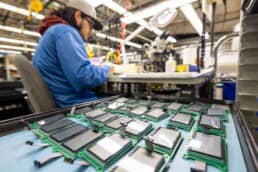
competitive advantage.
In addition, teaming up with a contract assembly partner enables OEMs to tap into years of know-how and expertise. Contract manufacturers have decades of experience with various products and industries, giving OEMs confidence in complete, accurate assembly processes.
At RiverSide Integrated Solutions (RIS), we provide comprehensive product assembly solutions. We can build subassemblies ready for installation into final products or even build products start-to-finish. Our experience provides us insight and recommendations that add value for our customers.
2. CONTRACT ASSEMBLY PARTNERS VARY SIGNIFICANTLY IN CAPABILITIES AND SOLUTIONS OFFERED
Not all contract manufacturers are created equal. They vary in capabilities, quality assurance and range of solutions. Thus, not every assembly partner will fit your business well.
Proven contract assembly partners are specialized in their craft, resulting in higher consistency and reliability of the product. With RIS, expect the hands-on care of a small operation and the capabilities characteristic of a larger company.
Contract manufacturers with various offerings can provide support as your business grows over time. RIS is an integrated manufacturer, which means we perform multiple steps along the supply chain. We offer manufacturing and value-added operations such as assembly, kitting, distribution and fulfillment.
Integrated manufacturers offer significant value to OEMs. They streamline production schedules, improve the consistency and reliability of the product and minimize the vendors involved.
At RIS, we have the capabilities, capacity, quality assurance standards and resources to support your manufacturing needs. We provide OEMs with complete manufacturing solutions.
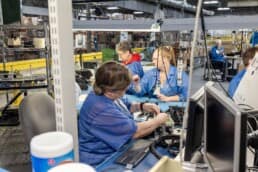
3. COST IS NOT THE ONLY FACTOR WHEN CONSIDERING CONTRACT ASSEMBLY
Many OEMs pursue contract assembly because of the appreciable cost and time savings it delivers. Whether outsourcing multiple supply chain steps or only product assembly, OEMs will gain efficiencies. It reduces expenses, lead times and overall costs. However, price is only one of the factors to consider when partnering with a contract manufacturer.
Intellectual Property (IP) and data security are invaluable to a business. However, many companies do not give enough consideration to it when
evaluating contract assembly. Compromised security or an IP leak could be disastrous for an OEM. Thus, companies must protect their IP and data.
Also, it is essential to understand IP and data security laws, especially if considering contract assembly in another country. OEMs must select a trustworthy partner, like RIS. We can protect IP and ensure data security for all sections of the supply chain, including product assembly.
About RiverSide Integrated Solutions
RIS is an advanced contract manufacturer providing robust solutions in circuit board assembly and product assembly. We employ more than 350 people and provide services to OEMs worldwide. We operate two state-of-the-art manufacturing facilities within the US.
With all of the choices in contract manufacturers out there, we know it can be challenging to find someone who understands your business model and has your best intentions in mind. RIS has always proven to be a win-win-focused relationship.
As your one-stop shop, we have the capabilities, capacity, quality assurance standards and resources to support all of your manufacturing needs. We understand that supply chain management is complex and very time-consuming, so we urge our customers to utilize us in the fullest capacity.
Our total-package solutions include:
- Extensive supply-chain network
- Full box-build assembly
- Dedicated Program Team
- Warehousing, kitting and drop-shipping capabilities
- Reverse logistics
- Flexible order fulfillment
- Scalability to meet your needs
Contact us today at (507) 523-3220 to see how we can help with your manufacturing project, or click contact us for a quote.
PCBA Best Practices
PCBA Best Practices
Electronic technologies continue to advance while the demand for more functionality increases. Similarly, designs for printed circuit boards (PCBs) and components keep getting smaller and more complex. Because of these changes, PCB assembly (PCBA) has become an even more crucial step in electronics manufacturing. Even a small assembly error could lead to poor performance or failure of an electronic device in the field. Original equipment manufacturers (OEMs) must work hard to ensure their assemblies are of the highest quality.
As the manufacturing of PCBs becomes more complex, more OEMs are turning to outsourcing their assembly needs. Given the criticality of PCBA, they must find a reliable contract manufacturer for these services.
RiverSide Integrated Solutions (RIS) is a knowledgeable contract manufacturer with years of experience specializing in PCBA. RIS has the requisite experience and proven know-how to guide OEMs through the PCBA process. We can select the right assembly technologies to ensure success in the field.
Below are some of our PCBA best practices to ensure your PCBA goes smoothly.
CLEAR COMMUNICATION UPFRONT
The best way to avoid PCBA issues is to collaborate with your partner upfront – before the detailed design begins. OEMs must communicate the functionality requirements and application of the PCB. Clear communication allows OEMs to tap into the experience and expertise of their partner. This often results in a better design, as well as a better production and assembly plan.
DESIGN FOR MANUFACTURABILITY AND ASSEMBLY
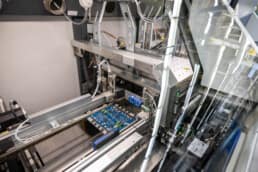
The easier to manufacture a product is, the more efficiently the manufacturing operations can run. Companies use design for manufacturability and assembly (DFMA) assessment to identify production and assembly issues early on. The result is more cost-effective production, better quality and quicker speed to market.
Click here for additional tips on implementing DFMA in your PCB designs. Designing PCBs with assembly in mind is crucial yet is often overlooked – leading to significant challenges.
Below are 3 broad concepts best applied during the DFMA process:
MINIMIZE COMPLEXITY
The team should evaluate each feature and functional requirement of the PCB for complexity. The goal is to minimize complexity without sacrificing requisite functionality.
STANDARDIZE
The PCB should be designed with common components and sizes compatible with standard assembly processes when possible. This simplifies the procurement of parts and PCB assembly, and saves OEMs time and money.
Additionally, specialized components often have longer lead times. Because of this, teams must ensure procurement of the desired parts without sacrificing the project schedule
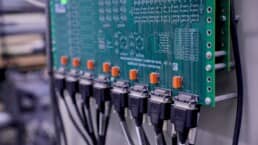
QUALITY
Finally, it’s important to remember that quality is not uniform across all PCB components and parts. Similarly, not all manufacturing partners assemble PCBs to the same degree of quality.
That’s why, it’s crucial to partner with a proven PCB assembler, like RIS. We have established quality control programs and a network of reliable suppliers. Let our years of hard work be your advantage!
RIS PCBA EXPERTISE
At RIS, PCB assembly is one of our core competencies. We provide reliable, seamlessly-assembled printed circuit board systems built with extreme precision.
Our skilled engineers, technicians and assemblers work to expertly put together a complete PCBA. When you choose RIS, you can expect the hands-on customer care of a small operation with the capabilities characteristic of a larger company. We provide our complete electronics manufacturing services for OEMs in any industry.
Our electronics assembly expertise includes:
- Surface Mount Technology (Fine-pitch, BGA (1 mm), µBGA (.4 mm), 01005, X-Ray, automated rework, and automated optical inspection (AOI)
- Magazine to Magazine handling
- Smart Shelving floor stock inventory control
- X-ray reel counting
- Lead-through auto-insertion (Axial, Radial, DIP, and Zierick Terminals)
- Wave Solder and Selective Solder Machines (No-clean & aqueous flux processes) RoHS and Tin/Lead capabilities
- Special Application Equipment (Cobot dispensing systems)
- Conformal coating (Silicone, Urethane)
- Potting (Epoxy, Urethane, and Silicone)
- Low-pressure molding technology
- Comprehensive product testing
- 3D Printing
About RiverSide Integrated Solutions
RIS is an advanced contract manufacturer providing robust solutions in circuit board assembly and product assembly. We employ more than 350 people and provide services to OEMs worldwide. We operate two state-of-the-art manufacturing facilities within the US.
With all of the choices in contract manufacturers out there, we know it can be challenging to find someone who understands your business model and has your best intentions in mind. RIS has always proven to be a win-win-focused relationship.
As your one-stop shop, we have the capabilities, capacity, quality assurance standards and resources to support all of your manufacturing needs. We understand that supply chain management is complex and very time-consuming, so we urge our customers to utilize us in the fullest capacity.
Our total-package solutions include:
- Extensive supply-chain network
- Full box-build assembly
- Dedicated Program Team
- Warehousing, kitting and drop-shipping capabilities
- Reverse logistics
- Flexible order fulfillment
- Scalability to meet your needs
Contact us today at (507) 523-3220 to see how we can help with your manufacturing project, or click contact us for a quote.
How Partnering with a Contract Manufacturer Strengthens Your Supply Chain
How Partnering with a Contract Manufacturer Strengthens Your Supply Chain
Optimizing the supply chain is a challenge that every company faces regardless of size or focus.
A company’s supply chain starts with raw material acquisition. It ends when the customer receives the final product. And it encompasses all suppliers participating in the sourcing, manufacturing, assembly and distribution processes in between.
Materials Management
One key aspect of a healthy supply chain is materials management. This broad category focuses on managing the flow of materials. Hence, the suitable material should arrive at the right spot at the right time.
Materials management is crucial and, if not executed correctly, results in an inefficient and disruptive supply chain. And an inefficient supply chain ultimately results in unsatisfied customers. The risk of such situations is why so many original equipment manufacturers (OEMs) turn to a contract manufacturer, like RiverSide Integrated Solutions (RIS).
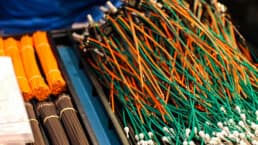
Contract Management
Contract manufacturing has been around for decades, and many industries rely heavily on outsourcing to strengthen their supply chain. Below are some areas where OEMs gain value from partnering with a proven contract manufacturer. At RIS, our customers enjoy a complete manufacturing solution. We provide supply chain value by minimizing the number of suppliers involved, enhancing product quality and reducing risk.
Some of the benefits of partnering with a contract manufacturer include:
Significant Cost Savings
Decreased expenses are a vital benefit of contract manufacturing. The cost savings come from various sources depending on how a company integrates along its supply chain. However, it can lower transportation and logistics expenses and eliminate markup fees from suppliers or wholesalers.
Integrated manufacturers, like RIS, provide an economy of scale that is impossible for OEMs or non-integrated suppliers. Manufacturers can use their size for negotiating power and buying in bulk—resulting in lower per-unit costs for OEMs.
Faster Speed to Market
Simply put, when a single entity controls multiple stages of the supply chain there are fewer disruptions and delays. Integrated manufacturers, like RIS, control more steps in the supply chain, which means we have fewer surprises. So when we have surprises, we can more effectively manage any problems that arise.
Additionally, the supply chain process flows more smoothly for integrated manufacturers. This allows them to get products to customers more rapidly and reducing time to market.
Improved Quality
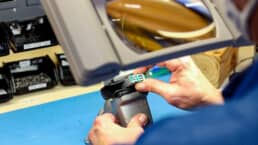
Another advantage of using a contract manufacturer is the access it opens up to your company. You get more advanced quality control processes and state-of-the-art technologies without having to undertake the expense of them yourself. Experienced contract manufacturers adhere to strict quality control processes which meet or exceed the requisite standards.
Contract manufacturing teams typically have rigorous quality training. They are also known for hiring dedicated professionals to ensure everything is up to their quality standard. They apply their breadth and depth of knowledge
across various industries to their quality management program. These measures lead to a higher level of quality control and result in more consistent and elevated product quality. They also result in a healthier bottom line and happier customers.
At RIS, we have a layered approach to quality management. We are ISO 9001 registered by each of our entities. We also adhere to quality systems that meet or exceed national standards for production procedures, product quality and customer service.
About RiverSide Integrated Solutions
RIS is an advanced contract manufacturer providing robust solutions in circuit board assembly and product assembly. We employ more than 350 people and provide services to OEMs worldwide. We operate two state-of-the-art manufacturing facilities within the US.
With all of the choices in contract manufacturers out there, we know it can be challenging to find someone who understands your business model and has your best intentions in mind. RIS has always proven to be a win-win-focused relationship.
As your one-stop shop, we have the capabilities, capacity, quality assurance standards and resources to support all of your manufacturing needs. We understand that supply chain management is complex and very time-consuming, so we urge our customers to utilize us in the fullest capacity.
Our total-package solutions include:
- Extensive supply-chain network
- Full box-build assembly
- Dedicated Program Team
- Warehousing, kitting and drop-shipping capabilities
- Reverse logistics
- Flexible order fulfillment
- Scalability to meet your needs
Contact us today at (507) 523-3220 to see how we can help with your manufacturing project, or click contact us for a quote.
The Value of Contract Assembly
The Value of Contract Assembly
Manufacturers are constantly under pressure to reduce costs while maintaining excellent quality. To achieve these objectives, original equipment manufacturers (OEMs) strategically outsource along the supply chain. One step that OEMs find valuable for outsourcing is contract assembly.
When partnering with a contract manufacturer like RiverSide Integrated Solutions (RIS), assembly becomes an extension of the manufacturing process. Our customers enjoy a complete manufacturing solution. We provide value by minimizing the number of suppliers involved, enhancing product quality and reducing risk.
Integrated providers like us streamline the supply chain with continuous production and assembly line flow. This reduces disruptions and improves efficiency – saving OEMs time and money.
OEMs need to consider outsourcing a step in their supply chain carefully. It is not a choice to be made lightly.
To help with this decision, we’ve summarized the main ways contract assembly adds value below. Also, please note that you can only realize this value when OEMs work with an experienced and proven partner. At RIS, we deliver efficiencies and maximize profits for all our customers.
MAXIMIZE PROFITS
Decreased expenses are the key benefit of contract assembly. Whether outsourcing multiple supply chain steps or only product assembly, you gain many efficiencies. It reduces expenses, lead times and overall costs.
Contract assembly allows OEMs to be nimble and more responsive. It also allows them to quickly capitalize on changing market conditions and customer demands.
LEVERAGE EXPERTISE
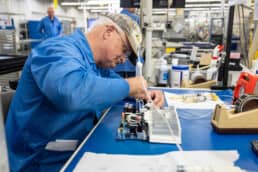
Teaming up with a contract assembly partner enables OEMs to tap into years of know-how and expertise. Contract manufacturers have decades of experience with various products and industries, giving OEMs confidence in complete, accurate assembly processes.
At RIS, we provide assembly solutions that include building time-consuming subassemblies ready for installation or making finished products. We use our experience to provide insights and recommendations that add value for our customers.
FEWER DISRUPTIONS
Outsourcing value-added operations such as assembly minimizes the risk of supply chain or process disruptions. For example, when OEMs outsource to a single supplier, they often avoid delays. They no longer need to manage production and logistics schedules across multiple vendors, saving them time.
Simply put, there are fewer surprises when OEMs minimize the number of vendors along the supply chain. Additionally, integrated manufacturers, like RIS, can more effectively manage any problems that arise. The supply chain process flows more smoothly. This gets products to customers more rapidly and reduces time to market – a significant value-add for OEMs.
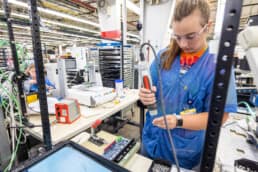
ENHANCED QUALITY
Contract assembly streamlines the production line, especially when combined with automation. This allows manufacturing to run seamlessly from production through assembly and beyond.
Regarding quality, contract assemblers are specialized in their craft, resulting in higher consistency and reliability of the product. Fewer vendors handling the product also eliminates the potential for quality disputes.
Lastly, since product flow is continuous, there is minimal “downtime” and less inventory is required. For these reasons, contract assembly saves time and money – and makes good business sense.
IMPROVED CUSTOMER EXPERIENCE
Contracting with a partner allows OEMs to avoid relying on suppliers. As such, they directly influence the customer experience throughout the supply chain – and have happier customers.
They’re also able to pass cost savings on to the customer, allowing for more competitive pricing and satisfied customers.
Finally, such integration enables manufacturers to track and control quality more closely. This results in fewer off-spec or returned products and a better overall customer experience.
About RiverSide Integrated Solutions
RIS is an advanced contract manufacturer providing robust solutions in circuit board assembly and product assembly. We employ more than 350 people and provide services to OEMs worldwide. We operate two state-of-the-art manufacturing facilities within the US.
With all of the choices in contract manufacturers out there, we know it can be challenging to find someone who understands your business model and has your best intentions in mind. RIS has always proven to be a win-win-focused relationship.
As your one-stop shop, we have the capabilities, capacity, quality assurance standards and resources to support all of your manufacturing needs. We understand that supply chain management is complex and very time-consuming, so we urge our customers to utilize us in the fullest capacity.
Our total-package solutions include:
- Extensive supply-chain network
- Full box-build assembly
- Dedicated Program Team
- Warehousing, kitting and drop-shipping capabilities
- Reverse logistics
- Flexible order fulfillment
- Scalability to meet your needs
Contact us today at (507) 523-3220 to see how we can help with your manufacturing project, or click contact us for a quote.
A Deeper Dive into PCBA Testing
A Deeper Dive into PCBA Testing
Comprehensive printed circuit board assembly (PCBA) testing is becoming more critical to the performance and functionality of circuit boards. This is especially true in sensitive and high-reliability industries such as medical, precision and industrial controls.
As these processes become complex, many original equipment manufacturers (OEMs) outsource part or all of their PCBA needs. Contract manufacturers like RiverSide Integrated Solutions (RIS) are knowledgeable in PCBA, testing and system integration.
We have the experience to assist customers with developing and executing a robust PCBA test program. Whether bringing a new product to market or trying to optimize an existing product, RIS is the right choice!
COMMON PCBA TESTING METHODS
Quality testing is an integral aspect of electronics manufacturing. There is always the potential for design issues, manufacturing defects or human error during fabrication and assembly. Testing is the checkpoint to catch these problems.
Testing is critical to the final product’s performance, functionality and reliability. It can identify and resolve quality issues before problems arise.
Some PCBs contain hundreds of components and thousands of solder connections. So, testing must be thorough and strategic to ensure a functional board. Various inspection and testing methods are available to ensure the quality of PCBs.
Below is a deeper dive into some key PCBA testing procedures.
IN-CIRCUIT TEST
This PCBA testing procedure is popular and provides a comprehensive test. The in-circuit test (ICT) is also known as the “bed of nails” test. The bed of nails is a set of electrical probes which send current through specified test points. This checks for defects, such as shorts and open circuits, misorientation of components and issues with the solder connections.
ICT is often designed for 100% defect coverage, resulting in around 85-95%.
However, ICT requires a specialized fixture with test points specific to each PCBA. Building or purchasing these fixtures adds incremental cost and time to the manufacturing process that is not profitable for many OEMs.
That’s why many choose to partner with RIS! Our customers get access to our test equipment, saving them time and money!
Since a fixture is required for each assembly, this testing method is a good fit for high-volume, “mature” designs. That is designs that do not expect significant revisions, as every redesign means redesigning the fixture as well.
FLYING PROBE
The flying probe test is a programmable software test. As suggested by the name, the test probes “fly” over test points on the board as directed. It tests for opens, shorts, resistance, capacitance, inductance and diode issues. This method can also measure voltage and check for diode and transistor orientations.
Flying probe does not require a custom fixture and, therefore, does not require tooling costs like the in-circuit test. However, the test takes longer, increasing the unit cost.
This method is typically a good choice for prototypes and small to medium volumes of PCBs. High volumes may take too long, especially if the boards are complex.
X-RAY INSPECTIONS
This PCBA testing procedure employs x-rays, as the name implies. It generates 2D or 3D images of the PCB solder joints. The software takes close-up, detailed images of a PCBA. Using this, a technician can identify defects in solder joints, connections, internal traces and barrels.
One of the main benefits of x-ray technology is that hidden parts of the PCB become “visible”. It reveals issues, such as solder voids, that may impact PCB functionality or integrity in the field.
This test method is usually most appropriate for prototypes or smaller volumes. This is because the process is often time-consuming and requires a trained technician.
RIS PCBA EXPERTISE
At RIS, PCB assembly is one of our core competencies. We provide reliable, seamlessly-assembled printed circuit board systems built with extreme precision.
Our skilled engineers, technicians and assemblers work to expertly put together a complete PCBA. When you choose RIS, you can expect the hands-on customer care of a small operation with the capabilities characteristic of a larger company. We provide our complete electronics manufacturing services for OEMs in any industry.
Our electronics assembly expertise includes:
- Surface Mount Technology (Fine-pitch, BGA (1 mm), µBGA (.4 mm), 01005, X-Ray, automated rework, and automated optical inspection (AOI)
- Magazine to Magazine handling
- Smart Shelving floor stock inventory control
- X-ray reel counting
- Lead-through auto-insertion (Axial, Radial, DIP, and Zierick Terminals)
- Wave Solder and Selective Solder Machines (No-clean & aqueous flux processes) RoHS and Tin/Lead capabilities
- Special Application Equipment (Cobot dispensing systems)
- Conformal coating (Silicone, Urethane)
- Potting (Epoxy, Urethane, and Silicone)
- Low-pressure molding technology
- Comprehensive product testing
- 3D Printing
About RiverSide Integrated Solutions
RIS is an advanced contract manufacturer providing robust solutions in circuit board assembly and product assembly. We employ more than 350 people and provide services to OEMs worldwide. We operate two state-of-the-art manufacturing facilities within the US.
With all of the choices in contract manufacturers out there, we know it can be challenging to find someone who understands your business model and has your best intentions in mind. RIS has always proven to be a win-win-focused relationship.
As your one-stop shop, we have the capabilities, capacity, quality assurance standards and resources to support all of your manufacturing needs. We understand that supply chain management is complex and very time-consuming, so we urge our customers to utilize us in the fullest capacity.
Our total-package solutions include:
- Extensive supply-chain network
- Full box-build assembly
- Dedicated Program Team
- Warehousing, kitting and drop-shipping capabilities
- Reverse logistics
- Flexible order fulfillment
- Scalability to meet your needs
Contact us today at (507) 523-3220 to see how we can help with your manufacturing project, or click contact us for a quote.
PCB Potting vs. Conformal Coating
PCB Potting vs. Conformal Coating
Electrical systems and devices are vulnerable to damage from various natural and artificial sources. Because of this, it is necessary to protect printed circuit boards (PCBs) to maintain performance and longevity.
Electronics may encounter various contaminants and operating conditions. Some common examples of vibration, impact, corrosion, rain, humidity, sweat, dirt, debris and extreme temperatures. For this reason, various ruggedization techniques have been developed to help protect electronics.
Two methods of PCB protection are conformal coating and potting. Original equipment manufacturers (OEMs) must understand these two options to select the correct protection method for each application.
Both techniques utilize polymers to protect PCBs, providing some electrical insulation and thermal and chemical resistance. However, the application method and level of protection offered varies.
The following compares PCB potting vs. conformal coating and provides guidance on when each method is appropriate.
RUGGEDIZATION TECHNIQUES AT RIS
At RiverSide Integrated Solutions (RIS), we have the experience and equipment to protect electronics used in high-stress situations. Contaminants like electromagnetic fields or vibrations can cause degradation and poor functionality.
Our expertise and extensive ruggedized electronics capabilities allow your assemblies to withstand even the harshest conditions. Our team can provide protective options, including potting and conformal coating. We can help you find the method that best applies to the operating environment of your device.
Watch this short video to learn more about our PCB potting and conformal coating techniques.
WHAT IS CONFORMAL COATING?
Conformal coating is a form of protection in which a machine applies a thin film to an assembled PCB. This layer acts as a shield to protect the assembly. It’s a good choice to protect against dust, dirt, moisture and other contaminants that can lead to corrosion.
There are several techniques for applying conformal coating. The most common is spraying. It is suitable for higher volumes of PCBs and known for its consistency.
Conformal coating layers are typically thin. The thickness can vary depending on the level of protection required.
As electronics become more complex, the use of conformal coating has become more prevalent.
Once you have decided on conformal coating for your PCBs, you’ll need to select the type of coating. At RIS, we offer various coating options, including silicone and urethane, that work well for various electronics applications.
ADVANTAGES & DISADVANTAGES
One of the key benefits of conformal coating is that it contributes minimal weight gain to electronic devices. This method is also relatively inexpensive and easier to apply.
The primary disadvantage of conformal coating is that it is only appropriate for low-level PCB protection. If an assembly needs to withstand more severe operating conditions, it will need another ruggedization technique.
WHAT IS POTTING?
PCB potting, or encapsulation, surrounds the PCB with a shell of protection instead of a coating layer. A pot or casing is constructed over the PCB to encase the device and then filled with liquid resin. The resin fills the pot, covering and sealing the PCB entirely.
Potting is a two-step process, which often takes longer than conformal coating. Additionally, the casing is thicker than the conformal coating, adding weight to the PCB.
There is some overlap in the chemistry of the polymers used in conformal coating and potting. The most common compounds used in potting are silicone, epoxy and urethane.
ADVANTAGES & DISADVANTAGES
The cons are that potting is typically more expensive than conformal coating and adds weight to the PCB. Also, there is no rework or repair option once the PCB is potted.
However, the additional thickness provides increased protection. So, the key advantage of PCB potting is its excellent protection. It has increased protection against heat, chemicals, water, shock and vibration damage.
WHICH PROTECTION IS BETTER: POTTING OR CONFORMAL COATING?
Naturally, OEMs often ask: Which method of PCB protection is better? The answer is that both ways are good choices and suitable for specific applications. Really, it depends on which method is best for your device.
OEMs should consider several factors when determining whether to use PCB potting or conformal coating for a given application.
These considerations will help determine the level of protection required for your PCB.
- PCB design, components and layout
- Cost and intended use of the device
- Operating conditions and environmental elements expected
- Level of protection provided by housing
As a general rule of thumb, conformal coatings are an excellent choice for applications that expect mild operating conditions. They may also require flexibility and have weight or thickness limitations.
For example, conformal coating is common with mobile and handheld electronics, such as phones.
Conversely, PCB potting provides additional protection and is, thus, an excellent option for applications that expect more extreme conditions. In these cases, a higher level of resistance to vibration, impact, abrasion, chemicals, moisture and temperature is required.
Often, equipment used in industrial or agricultural areas requires potting for added protection.
About RiverSide Integrated Solutions
RIS is an advanced contract manufacturer providing robust solutions in circuit board assembly and product assembly. We employ more than 350 people and provide services to OEMs worldwide. We operate two state-of-the-art manufacturing facilities within the US.
With all of the choices in contract manufacturers out there, we know it can be challenging to find someone who understands your business model and has your best intentions in mind. RIS has always proven to be a win-win-focused relationship.
As your one-stop shop, we have the capabilities, capacity, quality assurance standards and resources to support all of your manufacturing needs. We understand that supply chain management is complex and very time-consuming, so we urge our customers to utilize us in the fullest capacity.
Our total-package solutions include:
- Extensive supply-chain network
- Full box-build assembly
- Dedicated Program Team
- Warehousing, kitting and drop-shipping capabilities
- Reverse logistics
- Flexible order fulfillment
- Scalability to meet your needs
Contact us today at (507) 523-3220 to see how we can help with your manufacturing project, or click contact us for a quote.
3 Ways to Reduce Your Manufacturing Costs
3 Ways to Reduce Your Manufacturing Costs
In today’s competitive environment, Original Equipment Manufacturers (OEMs) are looking for opportunities to reduce costs while maintaining product quality. While several factors contribute to manufacturing costs, we will focus on three key ways to reduce cost: efficient product design, process automation and consolidation of suppliers.
Efficient Product Design
To save production costs, companies must ensure the product is as easy to manufacture as possible. This will result in more efficient production, better quality and lower cycle times.
Below are two best practices that will help you reduce cost.
Simplify the Product
Specific design features significantly impact part cost, such as tight tolerances and engraving. These drive up cost and directionally reduce production efficiency.
At RiverSide Integrated Solutions (RIS), we work with our customers to look at design alternatives and ensure any complex or intricate features are “must-haves.” And can and have brought in new technologies or 3D printed solutions to help manufacture for our customers at the lowest cost to them.
Minimize Material
Look for opportunities to reduce raw materials, such as replacing solid part sections with more hollow sections, without sacrificing quality or integrity. These design adjustments seem like a slight reduction in material. Still, when multiplied over many production runs, the result can be a significant decrease in manufacturing costs. Additionally, devices that weigh less are cheaper to transport and store, reducing manufacturing costs.
Leveraging Process Automation
Automation, and the efficiency it brings, has become a vital component in manufacturing. Automation can occur during the design phase through secondary operations. Companies should work with their manufacturing partner to design with automation in mind. For example, smooth products are more suitable for automated assembly processes.
Also, OEMs should be mindful of assembly orders and ensure that part orientation is consistent. These design considerations help ensure that automated processes downstream are optimized and efficient.
One form of automation is robotic work cells. These robots deliver speed and accuracy, resulting in lower cycle times and higher overall product quality. In addition, with an automated production line, personnel no longer have to execute repetitive, time-consuming tasks. This reduces the risk of human error and allows personnel to focus on more value-added responsibilities.
Additionally, highly-automated processes can be controlled by as little as one operator, further reducing labor and manufacturing costs.
Supplier Consolidation
The only constant in the manufacturing world is change. Over time, OEMs often find they have acquired an extensive supply chain that can be challenging and time-consuming to manage. One cost-cutting measure is consolidating your supply base into one or two strategic partners.
When working with a proven manufacturing partner like RIS, customers receive a complete manufacturing solution that strengthens their supply chain. As your one-stop-shop, RIS has the capabilities, capacity, quality assurance standards and resources to support all of your manufacturing needs.
Additionally, every step in the manufacturing process builds upon the next. Therefore, it is cost-effective to team up with a manufacturing partner that can start and end the project with you – from the concept and design phase through production and secondary operations.
There are many benefits to supplier consolidation including:
More Purchasing Power
By consolidating your supply chain, you will gain purchasing power. This can be in negotiating lower manufacturing and transport rates due to higher annual spending or lower raw material expenses due to more volume purchased.
Improved Communications
By consolidating your suppliers, your points of contact are significantly reduced, possibly down to a single point of contact at your crucial manufacturer. This allows for a central, more customized level of support. And this will also inevitably improve and simplify your supply chain communications, resulting in a better final product.
Easier to Manage
A smaller supplier base is simply more accessible. As a result, there are fewer suppliers to set up and manage within internal systems, and the relationship is easier to manage.
About RiverSide Integrated Solutions
RIS is an advanced contract manufacturer providing robust solutions in circuit board assembly and product assembly. We employ more than 350 people and provide services to OEMs worldwide. We operate two state-of-the-art manufacturing facilities within the US.
With all of the choices in contract manufacturers out there, we know it can be challenging to find someone who understands your business model and has your best intentions in mind. RIS has always proven to be a win-win-focused relationship.
As your one-stop shop, we have the capabilities, capacity, quality assurance standards and resources to support all of your manufacturing needs. We understand that supply chain management is complex and very time-consuming, so we urge our customers to utilize us in the fullest capacity.
Our total-package solutions include:
- Extensive supply-chain network
- Full box-build assembly
- Dedicated Program Team
- Warehousing, kitting and drop-shipping capabilities
- Reverse logistics
- Flexible order fulfillment
- Scalability to meet your needs
Contact us today at (507) 523-3220 to see how we can help with your manufacturing project, or click contact us for a quote.
4 Factors to Consider Before Your Next Product Assembly
4 FACTORS TO CONSIDER BEFORE YOUR NEXT PRODUCT ASSEMBLY
Complex assemblies can involve hundreds or thousands of parts and consume much of a company’s time. For this reason, many original equipment manufacturers (OEMs) are looking at product assembly for potential optimization.
The goal of any product assembly line is simple: efficiently assemble a product. It is important to keep this in mind when optimizing new or existing product assembly processes. To help with your evaluation, below are four factors to consider before your next product assembly.
1. IS YOUR PRODUCT DESIGNED FOR ASSEMBLY?
Design for Manufacturing (DFM) is a common practice. It is the process of designing a part for ease of manufacturing. It often results in a better, more cost-effective product.
DFM procedures often focus on production, but it is crucial that OEMs also consider product assembly. This way, they can ensure they optimize new or existing products for efficient assembly.
Whether you perform assembly in-house or outsource this activity, you must think it through. Thinking through detailed manufacturing steps and how the part design will impact this process is vital.
Companies should map out the physical flow of materials through each product assembly stage. This will help them identify areas for improvement and optimize the process.
Less is often more when it comes to product assembly. For instance, a best practice is to minimize the total parts and tools utilized. You should also attempt to optimize their placement, including orientation.
If performed properly, designing and optimizing for assembly will reduce manufacturing costs and avoid disruptions. However, the process should not sacrifice quality or performance.
2. DOES YOUR PRODUCT ASSEMBLY HAVE KEY METRICS?
Identifying key metrics for assessing and tracking manufacturing performance is crucial. These metrics should be easy for staff to measure. They should include quality assurance data based on inspections and other quality control practices.
This data, especially if available in real-time, will be invaluable to personnel making assembly decisions. Staff should also regularly analyze product assembly performance to identify areas for improvement.
3. HAVE YOU CONSIDERED DISASSEMBLY REQUIREMENTS?
Some products may need disassembly for inspections or repairs. When designing a product, disassembly needs are often disregarded. However, how a product disassembly significantly impacts the speed with which you complete support requests or tests.
Designers should consider disassembly requirements before every product assembly. For example, if there’s potential for maintenance in the future, consider your options. You may want to use flexible, temporary assembly methods rather than rigid, permanent fasteners, seals or other assembly methods.
4. DOES CONTRACT ASSEMBLY MAKE SENSE FOR YOUR PRODUCT?
If you are not already using contract assembly, it may be time to evaluate this option. Contract assembly has been around for decades, and many industries rely heavily on outsourcing product assembly to remain competitive.
Contract manufacturers, like RiverSide Integrated Solutions (RIS), can often complete assemblies faster than the OEM. At RIS, we provide OEMs with more rapid deliveries and increased speed to market. When outsourcing, OEMs are now unrestricted by in-house equipment or the number of personnel. They can operate in parallel with their contract manufacturer.
Additionally, contract manufacturers have the necessary tools and skilled workforce to complete complex assemblies. At RIS, we often have the capability of assembling at a higher quality level than our customers.
Contract manufacturers are more nimble and able to readily slot in additional orders. This flexibility is crucial to OEMs wishing to capitalize on market conditions. We can help you grow your business and improve customer satisfaction.
About RiverSide Integrated Solutions
RIS is an advanced contract manufacturer providing robust solutions in circuit board assembly and product assembly. We employ more than 350 people and provide services to OEMs worldwide. We operate two state-of-the-art manufacturing facilities within the US.
With all of the choices in contract manufacturers out there, we know it can be challenging to find someone who understands your business model and has your best intentions in mind. RIS has always proven to be a win-win-focused relationship.
As your one-stop shop, we have the capabilities, capacity, quality assurance standards and resources to support all of your manufacturing needs. We understand that supply chain management is complex and very time-consuming, so we urge our customers to utilize us in the fullest capacity.
Our total-package solutions include:
- Extensive supply-chain network
- Full box-build assembly
- Dedicated Program Team
- Warehousing, kitting and drop-shipping capabilities
- Reverse logistics
- Flexible order fulfillment
- Scalability to meet your needs
Contact us today at (507) 523-3220 to see how we can help with your manufacturing project, or click contact us for a quote.

